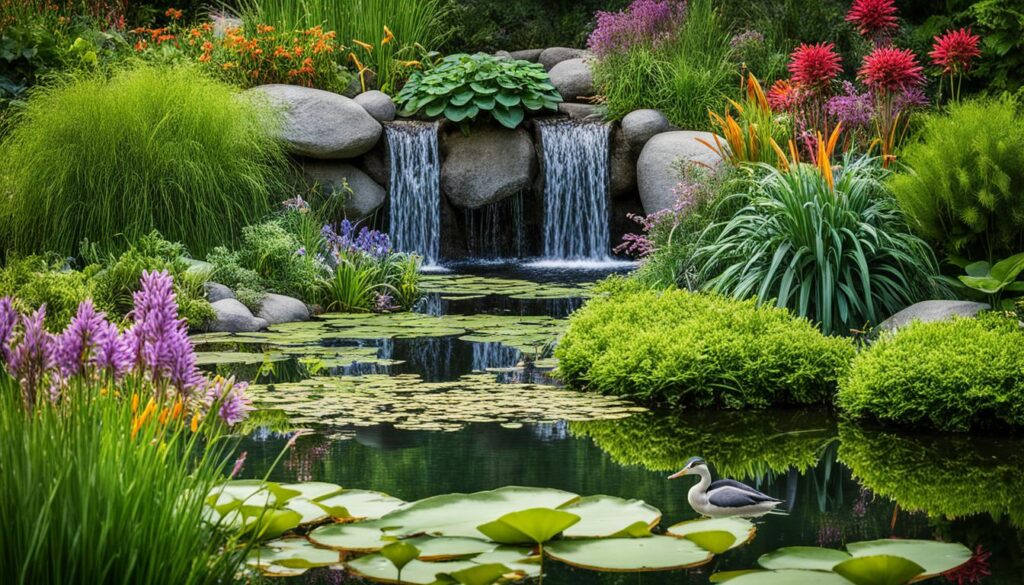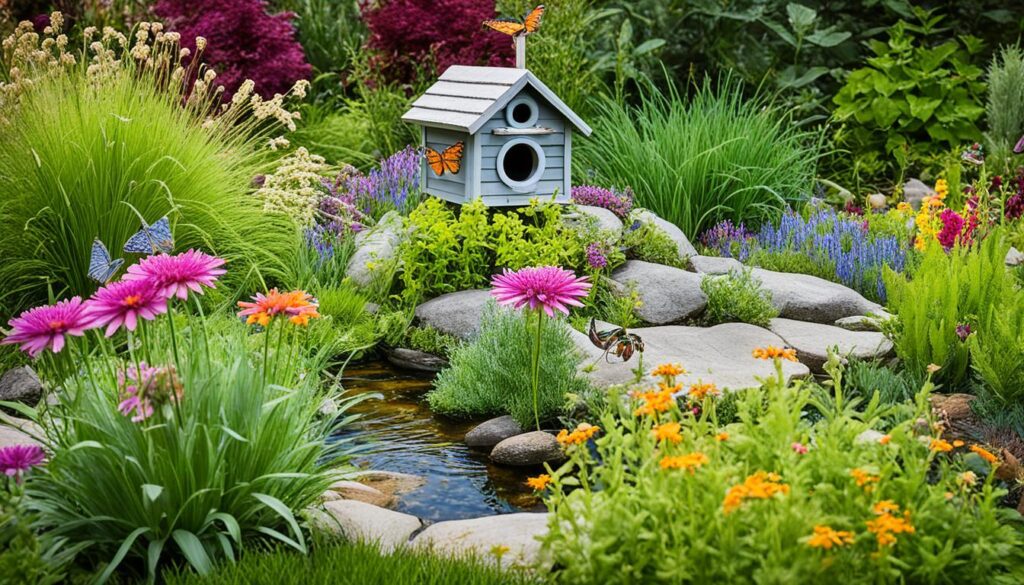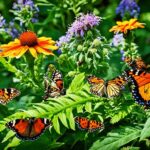How to Attract Beneficial Wildlife to Your Garden
Ever thought about making your garden a home for many creatures? It’s all about creating a space that meets the needs of local wildlife. With a few easy changes, your garden can become a safe spot for pollinators, birds, and small animals.
Key Takeaways
- Grow native plants to attract pollinators and provide food and shelter for wildlife
- Offer supplemental food and water sources to support a variety of species
- Create shelters and nesting spots to give wildlife a safe place to live and raise their young
- Maintain a compost pile to recycle organic matter and provide a nutrient-rich habitat
- Avoid pesticides and embrace natural, organic gardening practices
Imagine your garden as a lively oasis for many creatures. Learn how to make your outdoor area a welcoming place for pollinators, birds, and wildlife.
Grow Native Plants for Wildlife
Native plants are crucial for a wildlife-friendly garden. They’ve grown with local animals, offering them food, shelter, and resources. By using many native species, you’ll draw in different kinds of wildlife to your garden.
Native Wildflowers for Pollinators
Native wildflowers help pollinators like bees, butterflies, and hummingbirds. Great choices include forget-me-not, red campion, foxglove, and chamomile. These flowers make your garden look great and feed pollinators all season.
Trees and Shrubs that Provide Shelter and Food
Native trees and shrubs are key for wildlife. Think about adding silver birch, wild cherry, dogwood, and dog rose. They give shelter, nesting spots, and food like berries and seeds to birds, insects, and small mammals.
With a mix of native plants, your garden will become a lively place for wildlife. From pollinators to songbirds, it will be full of activity and life.
“Incorporating native plants is the single most effective thing a homeowner can do to support local wildlife.”
Provide Supplemental Food and Water Sources
Attracting wildlife to your garden isn’t just about native plants. Adding food and water can really help local animals. Whether you want to feed birds or help pollinators, the right additions can turn your garden into a wildlife paradise.
Feeding Birds and Butterflies
Setting up bird feeders with seeds, nuts, and suet can attract many birds. You’ll see everything from bright cardinals to busy woodpeckers. For butterflies and pollinators, plant nectar-rich flowers or leave out ripe fruit. They love it!
When you offer wildlife feeding, keep things balanced. Don’t let animals rely too much on your food. Clean your feeders often to keep them healthy. With care, you can create great bird feeders and butterfly nectar sources for your garden.
“Providing a diversity of food sources, both natural and supplemental, is key to supporting a wide range of wildlife in your backyard.”
| Supplemental Food Source | Wildlife Attracted |
|---|---|
| Bird Feeders (seeds, nuts, suet) | Songbirds, Woodpeckers, Chickadees, Nuthatches |
| Nectar-Rich Flowers | Butterflies, Hummingbirds, Bees, Moths |
| Rotting Fruit | Butterflies, Beetles, Flies |
Create Shelters and Nesting Spots
Turn your garden into a wildlife paradise by adding shelters and nesting spots. Use bird houses, bug hotels, frog pots, and hedgehog houses to draw in many creatures. These places offer protection from predators and harsh weather. They also provide breeding and shelter for various species.
When picking shelters, think about what the local wildlife needs. Make sure bird houses have the right size and entrance for the birds. Bug hotels should have different chambers and materials for various insects. Choose hedgehog houses with lots of space and soft bedding for these prickly visitors.
| Shelter Type | Suitable Wildlife | Key Features |
|---|---|---|
| Bird Houses | Songbirds, Woodpeckers | Varied entrance sizes, Proper ventilation, Durable materials |
| Bug Hotels | Bees, Ladybugs, Lacewings | Diverse chambers, Natural materials, Sheltered location |
| Hedgehog Houses | Hedgehogs | Ample space, Cozy bedding, Sheltered entrance |
| Frog Pots | Frogs, Toads | Partially buried, Moist substrate, Hiding spots |
Choosing and placing the right shelters can really boost the variety of species in your garden. These safe spots turn your garden into a sanctuary for many helpful creatures.
Add a Water Feature like a Pond
Having a reliable water source is key for drawing and keeping wildlife in your garden. Even a small garden pond or a shallow dish of water can be a big help. Ponds offer drinking water and a spot for amphibians to breed. They also attract insects that feed birds and bats.
Benefits of a Garden Pond
Adding a water source for wildlife to your garden has many perks. It draws in a wide variety of species and supports a healthy ecosystem. A well-thought-out garden pond becomes a lively spot. Here, dragonflies, frogs, and even birds and mammals find shelter and food.
Designing a Wildlife-Friendly Pond
When making a wildlife-friendly pond, think about sloping edges, aquatic plants, and different depths. This setup supports a variety of species. By adding these features, your garden turns into a haven for many beneficial creatures.
- Include sloping edges to allow easy access for drinking and bathing
- Incorporate aquatic plants to provide shelter and food for pond-dwelling creatures
- Vary the depth of the pond to accommodate different species

“A garden pond is a magical addition to any outdoor space, transforming it into a vibrant hub of life and activity.”
Maintain a Compost Pile
Creating a compost pile in your garden is great for many decomposer organisms like worms, slugs, and snails. These creatures are key in breaking down organic matter and giving nutrients back to the soil. Compost heaps also give shelter and places to survive the winter for small animals. Keeping a healthy compost pile boosts your garden’s biodiversity.
To start with composting for wildlife, just follow these easy steps:
- Pick a good spot for your garden compost pile, ideally in a shaded area to keep it moist.
- Gather different organic materials, like dead leaves, plant cuttings, and kitchen scraps (but not meat or dairy).
- Layer the materials in the pile, switching between “green” (high in nitrogen) and “brown” (high in carbon) stuff.
- Turn and aerate the compost often to help it break down evenly and stop bad smells.
- Check the compost’s moisture and add water if it’s too dry.
- Wait a few months for the compost to fully mature before adding it to your garden soil.
By keeping a compost pile healthy, you feed your garden and help a wide range of decomposer organisms. These are crucial for a strong, lively ecosystem.
| Benefits of Composting for Wildlife | Composting Tips |
|---|---|
|
|
“Composting is one of the best ways to support the natural cycle of life in your garden and create a thriving ecosystem.”
wildlife gardening
Creating a lush, vibrant garden can greatly impact the local ecosystem. Wildlife gardening means looking at your garden as part of nature. By using fewer pesticides and letting some areas be wild, you can boost the biodiversity of your garden.
Small changes like longer grass or a log pile can help many species. Seeing your garden as part of a bigger ecosystem helps it become a haven for wildlife.
Choosing sustainable gardening practices is good for the planet and makes your garden more interesting. When planning your garden, pick native plants that fit your climate. These plants will feed and shelter many creatures.
“A garden is a grand teacher. It teaches patience and careful watchfulness; it teaches industry and thrift; above all it teaches entire trust.” – Gertrude Jekyll
By making your garden wildlife-friendly, you help local ecosystems and create a lively outdoor space. Watch and learn about the creatures in your garden. Let their needs guide your gardening.

A great garden is more than pretty. It’s about living in harmony with nature. By embracing biodiversity in urban gardens, your garden will buzz with life.
Avoid Pesticides and Embrace Natural Growth
Creating a garden that’s good for wildlife doesn’t mean using harsh chemicals. It’s important to use fewer synthetic pesticides to keep your garden’s ecosystem balanced. Instead, try organic pest control and let nature take its course.
Alternatives to Pesticides
There are many ways to keep pests away from your garden naturally. Start by attracting helpful insects like ladybugs and lacewings, which eat garden pests. Planting certain herbs and flowers together can also keep pests away.
- Hand-pick larger pests like aphids or caterpillars off your plants.
- Use physical barriers like row covers or netting to protect vulnerable crops.
- Sprinkle diatomaceous earth or apply insecticidal soap to target specific pest infestations.
By using fewer chemicals and letting nature do its thing, your garden will be full of life. A bit of weeding and some minor damage to plants is worth it for a healthier garden.
“A garden is a grand teacher. It teaches patience and careful watchfulness; it teaches industry and thrift; above all it teaches entire trust.”
– Gertrude Jekyll
Plant a Wildflower Meadow
Turning your garden into a wildflower meadow is a great idea. It’s easy to care for and helps pollinators. Unlike regular lawns, it doesn’t need much work. It also gives a home to many insects, birds, and small animals.
To make a wildflower meadow, pick a spot that gets a lot of sun and drains well. Pick a mix of native wildflowers that bloom at different times. This way, there’s always food for the pollinators.
- Some popular wildflower meadow plants include:
- Coneflowers
- Blanket flowers
- Black-eyed Susans
- Butterfly weed
- Milkweed
- Planting many native wildflowers makes a healthy garden. It draws in lots of pollinators and wildlife.
- Keep your wildflower meadow tidy by mowing it a few times a year. Do this in late fall or early spring to stop weeds from taking over.
Adding a wildflower meadow to your garden is easy and makes a big difference. It helps local wildlife and looks beautiful. It gives pollinators lots of food and places to live, making your garden a haven for many creatures.
Incorporate Rock Gardens and Gravel Beds
If your garden has heavy clay soil, think about adding rock gardens and gravel beds. These areas are great for plants that love the sun and dry soil. They’re perfect for plants like succulents and alpine species. These plants attract special insects like mason bees that help pollinate them.
Rock gardens and gravel beds are easy to take care of and save water. They make your garden look interesting and support special plants and animals. By using gravel instead of soil, you’ll have fewer weeds, need less water, and can grow plants that love dry places.
Creating a rock garden or gravel bed takes time, but it’s worth it. These gardens become homes for special wildlife. They make your garden a place of beauty and life.
“Rock gardens and gravel beds are a game-changer for gardeners dealing with heavy clay soils. They allow you to introduce a whole new world of fascinating plants and the critters that depend on them.”
| Benefits of Rock Gardens and Gravel Beds | Drawbacks to Consider |
|---|---|
|
|
Looking to make a garden that’s easy to care for and helps wildlife? Adding rock gardens and gravel beds is a great idea. They’re beautiful and support special plants and animals.
Conclusion
By adding wildlife-friendly practices to your garden, you can make a space that helps many creatures. Growing native plants and offering food and water are simple steps. These actions help pollinators, birds, and other wildlife.
Helping your garden’s biodiversity makes your outdoor space more beautiful and supports the local environment. Following wildlife gardening tips can make your garden a better place. It also deepens your connection with nature.
By using wildlife gardening, you help keep your local ecosystem balanced. This creates a sustainable, lively outdoor area for the future.
FAQ
What are the key steps to creating a thriving wildlife garden?
Why are native plants ideal for attracting wildlife?
How can supplemental food sources benefit wildlife in your garden?
What types of shelters and nesting spots can you provide for wildlife?
How can a garden pond benefit wildlife?
What role does a compost pile play in a wildlife-friendly garden?
How can you use wildlife-friendly gardening practices to increase biodiversity?
What are the benefits of planting a wildflower meadow in your garden?
How can rock gardens and gravel beds attract specialized wildlife?
Source Links
- https://www.nhm.ac.uk/discover/seven-ways-to-create-a-wildlife-friendly-garden.html – Seven simple ways to create a wildlife-friendly garden
- https://www.rhs.org.uk/science/conservation-biodiversity/wildlife/encourage-wildlife-to-your-garden – No title found
- https://www.woodlandtrust.org.uk/blog/2020/06/attract-wildlife-to-your-garden/ – No title found
- 10 Must-Have Blooms for Your 2025 Garden
- The Health Advantages of Gardening You Need to Know
- How to Create a Small Vegetable Garden Layout Plan: A Beginner’s Guide
- DIY Garden Projects for Small Spaces: Upcycling Ideas to Maximize Your Garden
- Watering Techniques for Small Gardens: Ensuring Your Plants Thrive
- Small Border Plants for Landscaping: Adding Beauty and Functionality to Your Garden
- Year-Round Small Space Gardening: Seasonal Planting Tips for Maximum Harvest
- Essential Tools for Small-Space Gardening: What You Really Need
- The Ultimate Guide to Container Vegetables: What to Grow in Small Spaces
- Budget-Friendly Gardening: How to Create a Thriving Garden on a Tight Budget
- How to Optimize Sunlight in Small Gardens: Tips for Better Plant Growth
- DIY Vertical Planters: Creative Ideas for Small Space Gardening
- Companion Planting for Small Vegetable Gardens: Boost Growth and Deter Pests
- Container Gardening Essentials: Choosing the Right Pots, Soil, and Plants
- Vertical Gardening Techniques: Maximizing Your Small Space with Climbers and Vines
- How to Build a Raised Bed Garden in a Small Backyard: Step-by-Step Guide
- The Best Vegetables for Small-Space Gardens: High-Yield Varieties You Need to Grow
- Smart Vegetable Garden Layouts for Small Spaces: Maximizing Your Green Thumb in Compact Areas
- 40. Best Practices for Managing a Sustainable Garden Year-Round
- Building a Wildlife Pond for Biodiversity
- Advanced Techniques in Sustainable Gardening
- How to Create a No-Till Garden
- The Mental Health Benefits of Gardening
- Using Technology to Enhance Sustainable Gardening
- Getting Certified Organic: Steps and Benefits

Leave a Reply